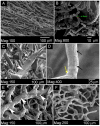The collateral network concept: a reassessment of the anatomy of spinal cord perfusion
- PMID: 21419903
- PMCID: PMC3062787
- DOI: 10.1016/j.jtcvs.2010.06.023
The collateral network concept: a reassessment of the anatomy of spinal cord perfusion
Abstract
Objective: Prevention of paraplegia after repair of thoracoabdominal aortic aneurysm requires understanding the anatomy and physiology of the spinal cord blood supply. Recent laboratory studies and clinical observations suggest that a robust collateral network must exist to explain preservation of spinal cord perfusion when segmental vessels are interrupted. An anatomic study was undertaken.
Methods: Twelve juvenile Yorkshire pigs underwent aortic cannulation and infusion of a low-viscosity acrylic resin at physiologic pressures. After curing of the resin and digestion of all organic tissue, the anatomy of the blood supply to the spinal cord was studied grossly and with light and electron microscopy.
Results: All vascular structures at least 8 μm in diameter were preserved. Thoracic and lumbar segmental arteries give rise not only to the anterior spinal artery but to an extensive paraspinous network feeding the erector spinae, iliopsoas, and associated muscles. The anterior spinal artery, mean diameter 134 ± 20 μm, is connected at multiple points to repetitive circular epidural arteries with mean diameters of 150 ± 26 μm. The capacity of the paraspinous muscular network is 25-fold the capacity of the circular epidural arterial network and anterior spinal artery combined. Extensive arterial collateralization is apparent between the intraspinal and paraspinous networks, and within each network. Only 75% of all segmental arteries provide direct anterior spinal artery-supplying branches.
Conclusions: The anterior spinal artery is only one component of an extensive paraspinous and intraspinal collateral vascular network. This network provides an anatomic explanation of the physiological resiliency of spinal cord perfusion when segmental arteries are sacrificed during thoracoabdominal aortic aneurysm repair.
Copyright © 2011 The American Association for Thoracic Surgery. Published by Mosby, Inc. All rights reserved.
Figures







References
-
- Heinemann MK, Brassel F, Herzog T, Dresler C, Becker H, Borst HG. The role of spinal angiography in operations on the thoracic aorta: myth or reality? Ann Thorac Surg. 1998;65(2):346–51. - PubMed
-
- Kieffer E, Richard T, Chiras J, Godet G, Cormier E. Preoperative spinal cord arteriography in aneurysmal disease of the descending thoracic and thoracoabdominal aorta: preliminary results in 45 patients. Ann Vasc Surg. 1989;3(1):34–46. - PubMed
-
- Williams GM, Perler BA, Burdick JF, Osterman FA, Jr, Mitchell S, Merine D, et al. Angiographic localization of spinal cord blood supply and its relationship to postoperative paraplegia. J Vasc Surg. 1991;13(1):23–33. discussion -5. - PubMed
-
- Williams GM, Roseborough GS, Webb TH, Perler BA, Krosnick T. Preoperative selective intercostal angiography in patients undergoing thoracoabdominal aneurysm repair. J Vasc Surg. 2004;39(2):314–21. - PubMed
-
- Kawaharada N, Morishita K, Fukada J, Yamada A, Muraki S, Hyodoh H, et al. Thoracoabdominal or descending aortic aneurysm repair after preoperative demonstration of the Adamkiewicz artery by magnetic resonance angiography. Eur J Cardiothorac Surg. 2002;21(6):970–4. - PubMed
Publication types
MeSH terms
Grants and funding
LinkOut - more resources
Full Text Sources

